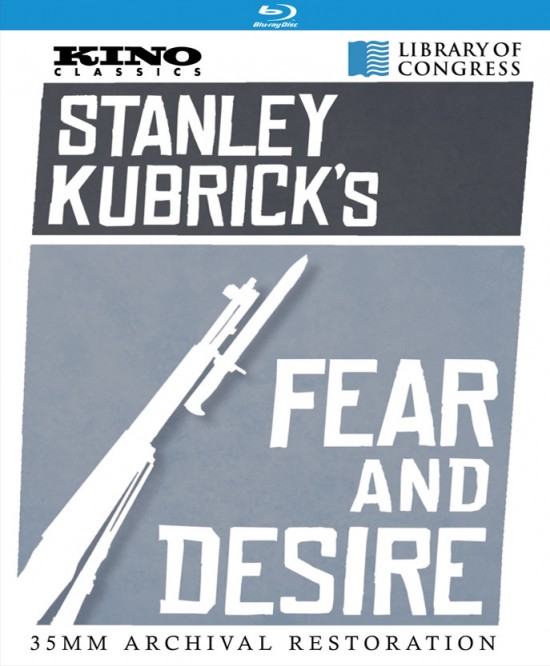Stanley Kubrick's Lost Film Debut 'Fear And Desire' Coming To Blu-Ray
Stanley Kubrick never wanted you to see Fear and Desire. The 1953 film was his feature debut, but the director took prints out of circulation and fought a constant battle against it screening in any form for decades afterward. This self-censorship by one of the greatest filmmakers of all time gave the film an underground cult status, making it a must-see for film fans lucky enough to get their hands on a bootleg version. When Kubrick passed away in 1999, however, the film began popping up more often. Now, after over half a century out of the mainstream, Fear and Desire is coming to Blu-ray on October 23. Read the press release after the jump.
Here's the box art for Fear and Desire, followed by the press release:
New York, NY – August 6, 2012 – Kino Lorber Inc. announces the release of Stanley Kubrick's rarely-seen first feature film, FEAR AND DESIRE, newly restored by the Library of Congress.
The event marks a major milestone for Kubrick aficionados as, in the years since its original release in 1953, FEAR AND DESIRE has rarely screened to the public, and has never been given a proper video release in any format.
This film has been restored at the Library of Congress Packard Campus for Audio Visual Conservation in Culpeper, Virginia, and will debut on Blu-ray and DVD on October 23, 2012.
"It's both the mission and privilege of the Packard Campus to preserve the breadth and depth of America's film, video, and sound recording heritage," said Mike Mashon, Head of the Library of Congress Moving Image Section. "Yet preservation is only a means towards making these treasures more accessible. We're pleased that FEAR AND DESIRE can now been seen but also well protected for generations to come."
"Kino Lorber is immensely grateful to the talented team at the Library of Congress for brilliantly restoring such a key work in the history of American cinema," said Kino Lorber CEO Richard Lorber.
"We're honored to participate in the process of making sure this seminal film of a 24-year-old Stanley Kubrick will now be widely available-an inspiration for film students and a thrill for film lovers everywhere."
ABOUT THE FILM
An existential war film that is often compared with Kubrick's PATHS OF GLORY (1957)-among three Kubrick films selected for the Library's National Film Registry-and FULL METAL JACKET (1987), FEAR AND DESIRE follows a squad of soldiers who have crash-landed behind enemy lines and must work their way downriver to rejoin their unit.
In the process, they encounter a peasant girl (Virginia Leith) and tie her to a tree, where she is tormented by a mentally unbalanced soldier (future director Paul Mazursky). Before making their escape, the soldiers determine the location of an enemy base and formulate a plot to assassinate its commanding officer.
Independently financed, and shot by a skeleton crew – with Kubrick controlling almost every aspect of production – FEAR AND DESIRE was conceived as a European-style art film, cloaked in the guise of a Hollywood war picture. Kubrick described the film to distributor Joseph Burstyn as allegorical and poetic. "A drama of 'man,' lost in a hostile world-deprived of material and spiritual foundations-seeking his way to an understanding of himself, and of life around him."
Burstyn acquired the film for distribution, and released it along with such art house fare as Roberto Rossellini's THE MIRACLE, Morris Engel's LITTLE FUGITIVE, and Luis Bunuel's EL BRUTO.
While it did receive some favorable notices, Kubrick's film was often dismissed as being too pretentious, and quickly disappeared from the screen. In 1971, Kubrick told writer Alexander Walker, "The ideas we wanted to put across were good...but we didn't have the experience to embody them dramatically."
"It was very important to have this experience and to see with what little facilities and personnel one could actually make a film," Kubrick said, "This experience and the one that followed with KILLER'S KISS, which was on a slightly more cushy basis, freed me from any concern again about the technical or logistical aspects of filmmaking."
Though Kubrick has dismissed the film as "a bumbling amateur film exercise," the film has had its champions, even from its initial release. Variety called FEAR AND DESIRE, "a literate, unhackneyed war drama, outstanding for its fresh camera treatment and poetic dialogue." Author and critic James Agee reportedly took Kubrick out for a drink to offer encouragement to the young filmmaker.
"The need for encouragement of fresh talent and its fairly common concomitant, the audacity of youth, was never made more pointed than in FEAR AND DESIRE, the drama fashioned by a tiny group of young, independent film makers," wrote A.H. Weiler in The New York Times in 1953, "For, in essaying a dissection of the minds of men under the stress of war, Stanley Kubrick, 24-year-old, producer-director-photographer, and his equally young and unheralded scenarist and cast, have succeeded in turning out a moody, often visually powerful study of subdued excitements."
It is remarkable that FEAR AND DESIRE exists today, in any form. As Kubrick found his voice as a filmmaker, he grew more self-conscious about his early work, and preferred that it remain buried in the past. On those rare occasions when a print would surface, Kubrick took measures to halt-or at least limit-public screenings of the film.
Thanks to the preservation efforts of the Library of Congress, Kino Lorber, Inc. can share with the world FEAR AND DESIRE, fresh from the 24-year-old mind of the man who would become the most influential filmmaker of his generation

